White Bugs on Plants (Including Tiny Bugs): Pictures, Identification and Control

White bugs on plants can do tremendous damage to plant leaves, stems, roots, and flowers. Some small fuzzy white bugs bite into plant tissue, sucking plant juices and sap. You may notice other white insects that look like tiny whitish dots lurking under leaves. There are also white spider-like bugs that feed on sap from plants and cause leaves to turn yellow or brown.
This article is a guide to identifying white bugs on plants. You will find out what type of plant damage the white pests do. In addition, you will get handy tips on getting rid of white plant-infesting bugs.
How to Identify White Bugs on Plants
Identifying types of white plant bugs can be challenging. White plant bugs are usually identified by observing their behavior, examining their body shape, and noticing if they have wings or generally crawl on plants. Then, look for plant damage like yellow or brown leaves or wilting stems.
Here are some clues when trying to identify white bugs on plants. For example, little white bugs can have a lint-like, woolly, or furry appearance. These can be mealybugs or woolly aphids. White “bugs” with wings are generally whiteflies. But white bugs like scale insects and root aphids are hard to spot because they don’t move much.
Types of White Bugs on Plants (Overview)
White bugs on plants are typically types of mealybugs, aphids, whiteflies, spider mites, thrips, or scale insects. The most common white sap-sucking pests on indoor plants seem to be mealybugs. These white bugs look like cotton wool and bite into plant tissue. Common white bugs on outdoor plants are whiteflies.
Tiny White Bugs on Plants
Although people refer to any type of white pest on plants as bugs, not all are true bugs. White plant bugs are described as tiny white creatures with mouthparts for biting into plants and sucking juice. Additionally, white bugs rarely have wings but are plant-destroying crawling insects.
Types of true white bugs in the order Hemiptera include mealybugs, scale insects, and aphids. Other white-colored plant pests like whiteflies, thrips, and spider mites are not “true bugs.”
This article refers to all types of white arthropods that can infest plants as “white bugs.”
How to Get Rid of White Bugs on Plants
Getting rid of white bugs from plants requires diligence, patience, and effective eradication techniques. If you have tiny white fuzzy bugs on indoor plants, you should isolate the plant immediately. Then use a neem oil solution, insecticidal soapy water, or sticky traps to kill the annoying white bugs.
Eradicating white bugs from outdoor plants can be more challenging. For whitefly or aphid infestations, you can dislodge them with a strong spray of water from the garden hose.
Types of White Bugs on Plants (with Pictures and Identification)
Have you noticed white specks, white bugs, or white flies crawling on plant leaves, stems, or in the soil? If so, please continue reading to find out what those tiny white bugs are.
Mealybugs (Pseudococcidae)

Mealybugs look like small oval white fuzzy bugs on plant leaves and stems
Mealybugs are tiny white bugs that look like lint and bite into plant leaves and stems. The white soft-bodied insects are easy to mistake for fungus on plants. The little fuzzy bugs have a grayish-white appearance, like cotton wool. The white fluffy-looking bugs are 0.05” to 0.2” (1.2 – 5 mm) long.
Tiny white mealybugs are common on houseplants. In addition to looking white and fuzzy, the bugs are covered in a powdery wax-like substance. They tend to leave this white cottony substance on plant leaves and stems. Unfortunately, the annoying bugs also secrete honeydew, which can attract ants and cause black sooty mold.
Look for cottony masses of white wax on stems and leaves to identify mealybugs on houseplants. You can spot the tiny fuzzy white bugs by their oval body that tapers at the tail end. The white bugs are usually found on the underside of leaves, stems, and the outside of plant pots.
Mealybugs damage plants by sinking their mouthparts into plant tissue. The white sap-sucking bugs can reduce the strength of plants. Leaves start to wilt, turn yellow or brown. Heavy mealybug infestations can result in leaf drop and even plant death.
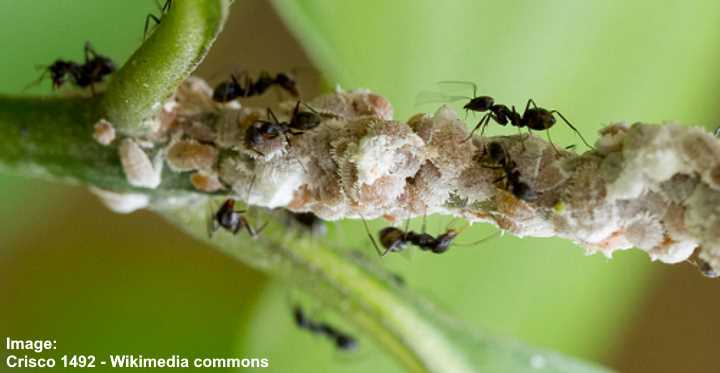
Mealybug infestation can damage plant growth when they feed on the plant’s sap
In addition, the black sooty mold can make the plant look unsightly and interfere with photosynthesis.
These plant-destroying tiny white creatures can also infest plants in your garden. Signs of mealybugs on outdoor plants include a white cotton wool-like substance on leaves, amber-colored sticky honeydew, ants around your plants, and an unsightly black powdery layer of “soot” on plant foliage.
Plant Damage Caused by White Bugs: White fluffy mealybugs biting into plants to suck sap causes stunted growth, yellowing leaves, and leaf or bud drop.
How to Identify the White Bug on Plants: Mealybugs are identified as white tiny fuzzy oval bugs with long tails that leave white powder. Mealybugs rarely move, and they congregate under leaves and in the leaf joints of stems.
How to Get Rid of the White Bug on Plants: Dip a cotton swab in rubbing alcohol and dab the white mealybugs to kill them instantly. You can also use insecticidal soap spray to treat mealybug infestations.
Related reading: How to kill mealybugs for good.
Whiteflies (Aleyrodidae)
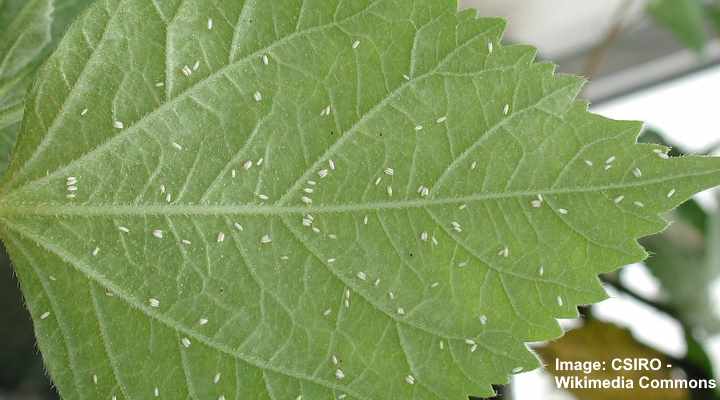
Adult silverleaf whiteflies on the underside of a leaf
Whiteflies are tiny white flying bugs that flutter in groups around plants. The white-colored flies are easy to identify because they become active when you disturb an infested plant. However, on a plant, whiteflies are tiny white bugs that look like dust and congregate under leaves.
Individual adult whiteflies can be challenging to spot because they are minuscule white flying insects. The tiny white bugs measure 0.04” (1 mm) long with a wingspan of 1.1” (3 mm). Whitefly eggs look like little white dots on the underside of leaves.
Tiny whiteflies damage plants by transferring toxic saliva when they bite into plant tissue. Large groups of the minuscule flying bugs can quickly damage foliage, causing it to turn yellow and drop. If left untreated, whiteflies can cause plant death.
Whiteflies are common pests on outdoor plants and greenhouse plants. The tiny moth-like insects feed on begonias, potato leaves, geraniums, fuchsia, and chrysanthemums. If you notice small white bugs on tomato plants, the chances are that they are whiteflies.
The little whitefly bugs can also affect houseplants. The fuzzy whiteflies also damage plants indoors by sucking plant sap, slowing down vigorous plant growth, and causing deformed leaves.

A close up picture of a whitefly
Another common feature of fuzzy sap-sucking bugs like whitefly is that they produce honeydew. This sticky substance encourages sooty mold growth that can cover leaves in a black substance.
In addition, whitefly also transmits plant diseases. Therefore, there are many reasons to get rid of whitefly from indoor and outdoor plants.
Plant Damage Caused by White Bugs: The little bugs look like tiny snowflakes that suck the life out of plants, causing leaves to turn yellow. As a result, the foliage will prematurely drop, and the plant can eventually die.
How to Identify the White Bug on Plants: Whiteflies are easy to identify when disturbing the plant. The swathes of tiny white flies will flutter around the plant. Look for small white dots on leaf undersides to identify whitefly larvae.
How to Get Rid of the White Bug on Plants: The easiest way to eradicate whitefly infestations from garden plants is to blast them with the garden hose. This dislodges the pesky white bugs. However, you will have to repeat the process to keep whitefly off your plants for good.
Related reading: How to get rid of whiteflies on plants.
White Aphids
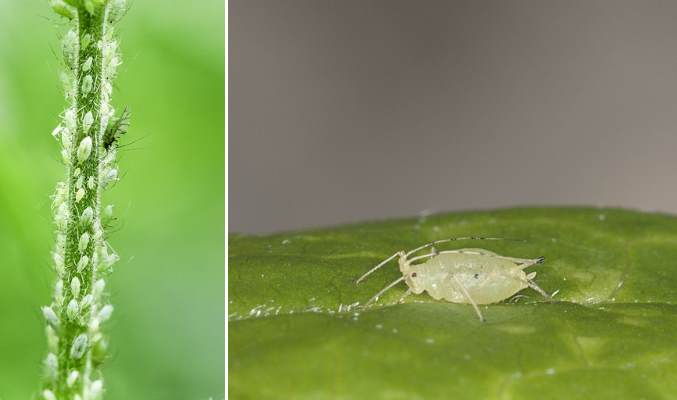
Aphids on plants look like tiny crawling insects with various colors depending on the species
White aphids are a type of true bug that looks like tiny greenish-white pear-shaped bugs with the tapered end at their head. The nasty white bugs destroy plants just like black aphids or green aphids. The little white bugs puncture plant tissue with their piercing mouthparts and feed on plant sap.
White aphids are difficult to identify because they are so tiny. The soft-bodied white oval bugs measure 0.04” to 0.08” (1 – 2 mm) long. The tiny white specks are usually only noticed when there is a heavy infestation on a houseplant or garden plant.
Plant Damage Caused by White Bugs: White aphids damage ornamental and houseplants, causing curled leaves, deformed flowers, and weak or distorted growth.
How to Identify the White Bug on Plants: The tiny white bugs look like small grains of rice crawling all over plants.
How to Get Rid of the White Bug on Plants: Get rid of white aphid bugs by wiping down foliage with insecticidal soap or neem oil solution. If aphids have infested garden shrubs and ornamental plants, knock them off the plant with a sharp spray of water.
Related reading: The best way to kill aphids for good.
Woolly Aphids (Eriosomatinae)
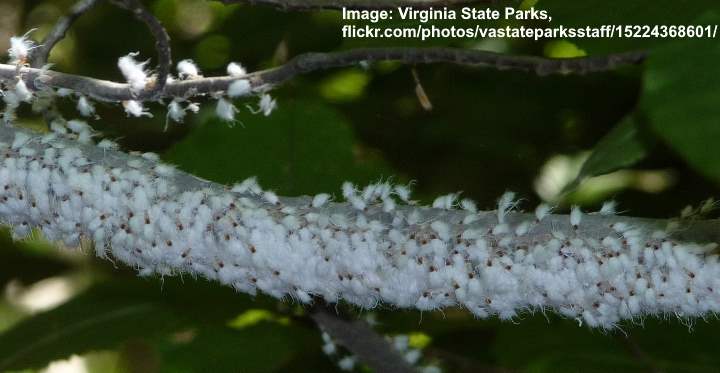
Woolly aphids include various species with white fuzzy coating
Woolly aphids are tiny fuzzy white bugs looking like lint that bite into plant tissue. When grouped together, the fluffy gnat-like bugs look like cotton or wool. Adult woolly aphids also have wings. The tiny furry white bugs use their mouthparts to pierce plant tissue to feed on sap.
Woolly aphids are white bugs that are almost microscopic. The cotton-like bugs grow 0.04” to 0.08” (1 – 2 mm) long. Due to their furry white appearance, white aphids are also called fluff bugs, snow bugs, cotton fairies, and fluffy gnats.
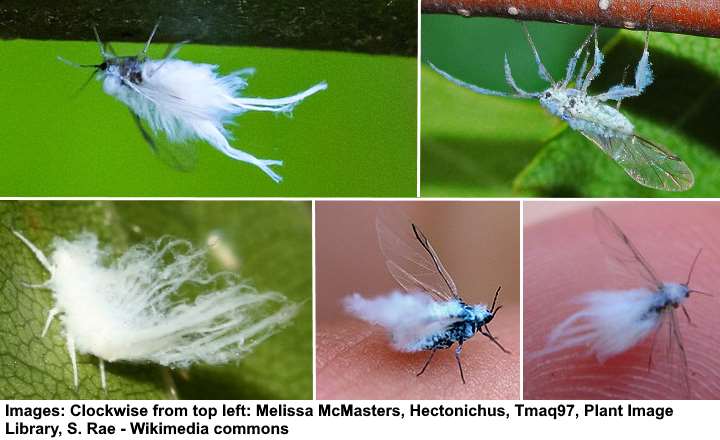
Close up images of various types of woolly aphids
Like most sap-sucking white fluffy bugs, white aphids also leave behind sticky honeydew, which can cause sooty mold on plants.
Plant Damage Caused by White Bugs: Woolly aphid damage causes twisted leaves, yellowing foliage, and weak plant growth. In addition, trees affected by masses of woolly aphids can develop cankers and galls.
How to Identify the White Bug on Plants: White aphid identification is by their fuzzy white appearance with a waxy coating covering their tiny bodies.
How to Get Rid of the White Bug on Plants: Neem oil is ideal as a natural insecticide to disrupt the white aphid life cycle and kill the pesky white bugs.
Related reading: How to get rid of woolly aphids from houseplants and outdoor plants.
Root Aphids
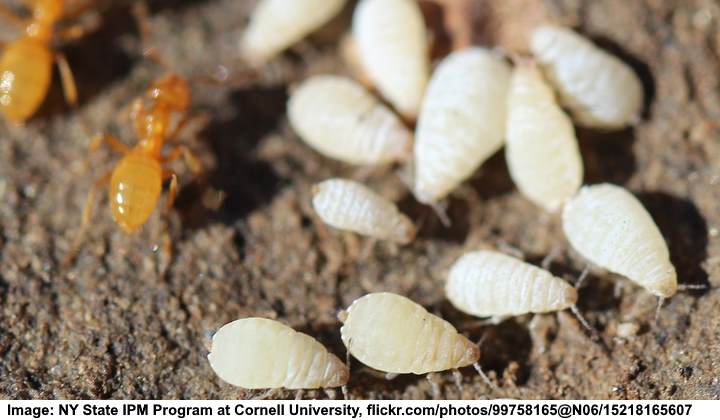
The pear shaped tiny white root aphids live in the soil and damage plant roots
Root aphids are nasty white, pear-shaped bugs that look like dust specks and are hard to spot. Root aphids are about the size of a mite and can be confused with mealybugs. The little white bugs live in the soil and damage plant roots. Root aphid plant damage looks like nutrient deficiencies.
Root aphids destroy plants by boring holes in roots. This destructive action causes curled, yellow leaves and small stunted fruit and flowers. Eventually, root aphids start crawling up stems to feed on foliage.
Plant Damage Caused by White Bugs: Root aphid plant damage typically occurs with an extensive infestation. As a result, you will see signs of stunted plant growth and withered foliage. With outdoor plants, you will also see an increase in ant activity near plants.
How to Identify the White Bug on Plants: Root aphids look like tiny white ticks that leave white sticky stuff on plants.
How to Get Rid of the White Bug on Plants: It’s best to destroy the entire plant because root aphids spread easily, and getting rid of them entirely is challenging.
White Spider Mites
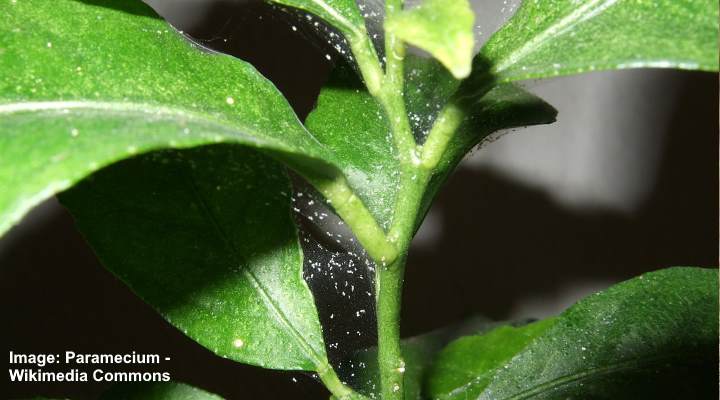
Spider mites on a lemon plant. The spider mites are the tiny white bugs on the sticky webs
White spider mites are tiny white bugs that look like dust particles on a plant. The white mites have eight legs like spiders. The first sign of a white spider mite infestation is web-like silken threads dangling from plant leaves. The almost microscopic white mites are so tiny—just 0.02” (0.5 mm) long.
The best way to look for evidence of spider mites is to check plants for webs. You may also see white specks like tiny rice when they cast off their skins. Additionally, weakened plant growth and damaged leaves are also indicators of white spider mite activity.
White spider mites can become a significant nuisance on indoor plants, greenhouse crops, garden bushes, and ornamental shrubs.
Plant Damage Caused by White Bugs: White spider mites can cause damage to plant leaves and also some vegetable crops like squash, peas, beans, and ornamental shrubs.
How to Identify the White Bug on Plants: Look for silky strands of thread or web-like structures hanging from leaves or stems.
How to Get Rid of the White Bug on Plants: Spray plants with a neem oil solution once a week to help get rid of white spider mites.
Related reading: Effective methods to eradicate spider mites naturally.
White Scale Insects

Scale insect infestation on plants
White scale insects are tiny white fuzzy bumps that look like specks of lint or minuscule rice grains. Some scale insects have a soft, white cottony appearance. Leaves and stems affected by scale can appear covered in grayish-white fluff. Other types of scale look like tiny white shell-like bumps.
There are two types of scale insect—soft scale and hard scale. Hard scales are harder to spot and kill because the bugs hardly move and sometimes look like parts of the branch. Soft scale insects like mealybugs tend to have a fuzzy white appearance.
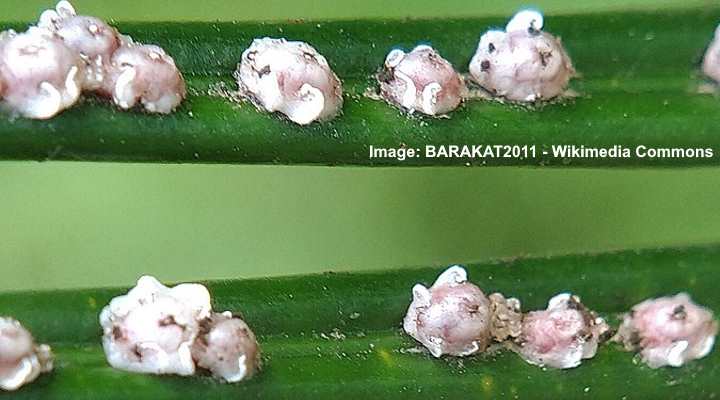
Wax scale infection on cycas leaf
Plant Damage Caused by White Bug: White scale insects on plants make the leaves look withered and sickly. In a severe infestation, twig dieback can occur, and the plant loses its vigor.
How to Identify the White Bug on Plants: White scale identification features are cottony-like, furry masses of white substances on stems and branches.
How to Get Rid of the White Bug on Plants: To get rid of white soft scale insects, spray affected foliage with horticultural oil. To get rid of hard scales, dab the hard shells with rubbing alcohol to kill the plant bugs.
Related reading: How to get rid of scale insects on plants.
Thrips
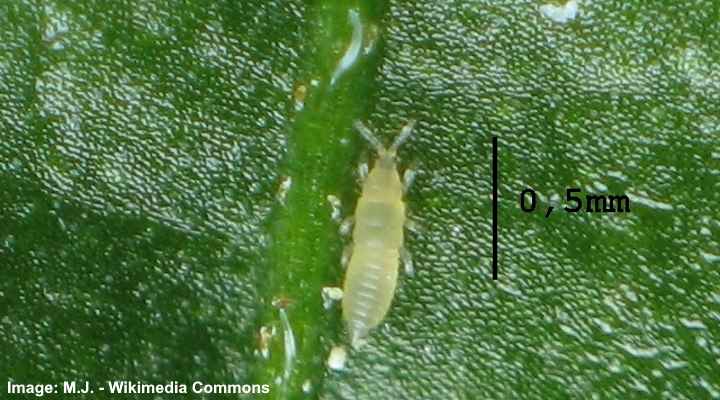
Thrip larvae (in the picture) is translucent creamy-white that turns into a black adult
Thrips are plants destroying bugs that can look like specks of white dust on a plant. Adult thrips are black. But the nasty plant pests lay eggs inside leaf tissue, and the immature thrips emerge as tiny white larvae. The first signs of thrip damage are silvery scratch marks and gray patches on leaves.
The tiny white bugs that look like rice do all the plant damage. The white or yellowish-green maggots feed on plant tissue, causing leaves to wither and die eventually.
Plant Damage Caused by White Bug: The tiny white thrip larvae cause tremendous damage to plant foliage, resulting in the leaves withering and dying.
How to Identify the White Bug on Plants: Thrips look like white specks on leaves.
How to Get Rid of the White Bug on Plants: Use a lint roller to get rid of the tiny white bugs, then spray the foliage with neem oil every seven days.
Related reading: How to get rid of thrips insects on plants.
Other Ways To Get Rid of White Bugs on Plants
If possible, always use natural pest control methods to eradicate and control infestations of white plant bugs. Here are some ideas for dealing with these pesky white plant-destroying creatures.
- Neem oil—Use a natural neem oil spray once a week as a natural insecticide to kill off fuzzy white bugs on plants. Make a neem oil spray with three ingredients—neem oil, liquid Castile soap, and warm water. Mix 2 tsp. neem oil and 1 tsp. liquid soap with 1 quart (1 l) of lukewarm water. Put the ingredients in a spray bottle and shake vigorously before using it to mix the ingredients.
- Insecticidal soap—Insecticidal soap sprays coat soft-bodied white bugs, causing them to suffocate.
- Sticky traps—Blue or yellow sticky straps are excellent for controlling flying white bugs like whiteflies.
- Strong blast of water—To get rid of whiteflies and aphids from outdoor plants, turn the hose on the infected plants to dislodge the sap-sucking white bugs.
Related articles:
